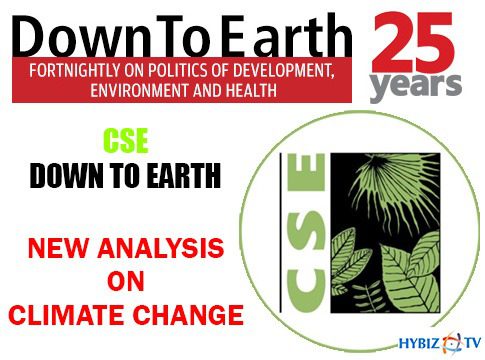CSE and Down To Earth New Analysis on Climate Change
CSE and Down To Earth New Analysis on Climate Change: Developed countries of the world are reneging on free trade in the name of climate change – says a new analysis and the subject of its latest cover story by Down To Earth magazine. Armed with massive subsidies and tariffs, the US and EU are leading this trend towards protectionism. This may change the global trade system as we know it.
Says Avantika Goswami, the writer of the Down To Earth report and programme manager for climate change at the New Delhi-based think tank Centre for Science and Environment (CSE): “In the race to build low-carbon economies, countries are introducing policies to speed up the transition from fossil fuels, promote manufacturing of clean energy technologies and decarbonise industries. On the face of it, this race appears to be part of the global effort to cut greenhouse gas emissions. But they have also sparked fears of trade wars, as governments on the pretext of climate action try to reshore green industries and dominate the global supply chain of goods and technologies essential to avert a climate catastrophe.”
CSE, which helps publish Down To Earth, recently organised an international webinar on the subject, which was addressed by Rob Davies, former minister of trade and industry in South Africa; Paul Butarbutar, executive director, Indonesia Centre for Renewable Energy Studies; Katie Gallogly-Swan, economic affairs officer, UNCTAD; Apratim Sahay, senior policy manager, Green New Deal Network; Sunita Narain, director general, CSE and editor of Down To Earth; and Goswami.
A new trade order: The machinations of the US and EU
In August 2022, the US passed the Inflation Reduction Act (IRA) – a bill offering about US $370 billion in subsidies, mainly through tax credits over 10 years, for renewable energy, electric vehicles, energy-efficient appliances, carbon capture and storage and clean hydrogen. This has rankled other green technology manufacturing powers like the EU, South Korea and Japan, which fear that their companies may jump ship and expand business in North America.
Says Goswami: “Developing countries like India cannot match the IRA’s scale of subsidies. If we take the example of electric vehicles (EVs) in our country, there are three incentive schemes that are offered – the Faster Adoption and Manufacturing of Electric Vehicles (FAME II) with an outlay of Rs 10,000 crore; and two Production-Linked Incentive (PLI) schemes of Rs 25,398 crore (automotive sector including EVs) and Rs 18,100 crore (battery storage), respectively.”
There is also the question of access to critical minerals. Prices of minerals in the global market are set by the big players. China is the biggest buyer today. Once the US enters this race for its own domestic manufacturing on a large scale, India will have to aggressively scale up its EV production to command prices on its own terms.
CSE experts suggest that India should focus on the EV sectors in which it has a ready domestic market — two-wheelers and three-wheelers, which constitute 63 per cent and 34 per cent of the domestic EV market. It can also become a hub for recycling of spent batteries, which will enable it to recover the processed critical minerals that it is currently lacking.
In December 2022, the EU reached a provisional agreement on a Carbon Border Adjustment Mechanism (CBAM) – a tax on imports of goods like steel and aluminium from countries with lax emission reduction rules. The CBAM has been criticised by BRICS countries, and India’s finance minister has warned the country’s firms to reset themselves and be ready for “tariff walls coming up newly in the name of climate change”.
According to UNCTAD (United Nations Conference on Trade and Development), if applied at US $44 per tonne, a CBAM will reduce global carbon emissions by not more than 0.1 per cent — but it will have an adverse distributional impact because it will decrease global real income by US $3.4 billion, with developed countries’ incomes rising by US $2.5 billion while developing countries’ incomes fall by US $5.9 billion. Other developed countries like the UK may follow suit and implement a carbon border tax.
When faced with the CBAM, developing countries need access to finance and technology to decarbonise their manufacturing sector so that export competitiveness is maintained. For India, the EU is its third largest trading partner – the Down To Earth report points out that India’s iron and steel and aluminium sectors would be the most exposed to CBAM, albeit to a lesser extent than other countries. India does not have one domestic carbon price – but it has an upcoming domestic carbon market, a national NDC and net zero target, and voluntary climate targets by industrial firms. Whether or not this patchwork of market-based schemes and climate signals will create a case for Indian industry to avoid the tariff burden from CBAM is yet to be seen, says Goswami.
Speaking at the webinar, Davies said: “A CBAM is directly attacking the market access of developing countries; and it could be expanded to all exports eventually. African countries are emitting the least, and the gain from imposing this tax on them would be minimal in terms of carbon emission reduction. We need to respond to these measures.”
As per UNCTAD, “policies like IRA and CBAM point to a missing developmental dimension in trade commitments, combined with growing evidence that industrialised economies are outsourcing pollution at the same time as they avail themselves of industrial policy tools to bolster their dominance within emerging green industries.”
Industrialisation has enabled sustained productivity growth in the EU and US, but industrial development has been an uphill battle for developing countries, in part due to trade agreements designed to constrain their policy space. WTO – heavily influenced by developed countries – treats subsidies, tariffs and export bans as “trade distorting”. Thus, current trade rules prevent developing countries from using local content and technology transfer requirements, or tools like government procurement to stimulate domestic industries. Now that rich countries are increasingly embracing industrial policy to ensure their economic resilience, it is difficult for them to prevent developing countries from implementing similar policies.
Echoing these sentiments expressed in Down To Earth, Katie Gallogly-Swan of UNCTAD said: “We need to reframe the trade rules for a time of climate change and address the long-standing concerns of developing countries. We need to strengthen the core principles of ‘special and differential treatment’ at WTO and ‘common but differentiated responsibilities’ in the UNFCCC process. A more positive agenda would support developing countries’ priorities, additional financing, green technology transfers, capacity building supporting environmentally sustainable economic diversification, and adequate policy and fiscal space to support their own integrated policies to advance towards their climate and developmental goals.”
In her concluding address, Sunita Narain from CSE said: “In this era of climate change, developing countries need to build self-sufficiency in domestic production of green technologies. They must be allowed to deploy ‘industrial policy’ tools like subsidies to forge their own equity and green development growth paths, without being subject to over-reaching trade rules. If a country is rich in green minerals, it should be able to deploy a set of policies that attempt to retain those minerals, process them domestically, and create jobs and a manufacturing sector and thus, build innovation and technology locally.
Narain added: “We should look at what rules will work for us best (the developing world), and work for us in a climate-constrained world. We need to make sure we can combat emissions, and at the same time, have economic growth. In doing so, maybe for the first time we will end up making a trade deal which does not work against the environment, but for it; a deal that works for people.”














